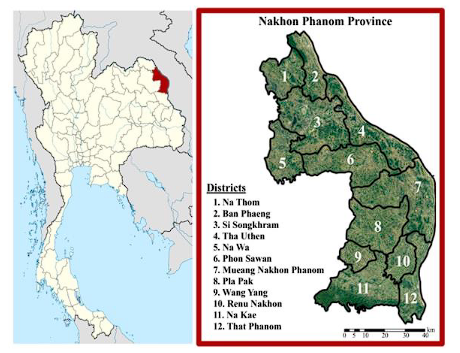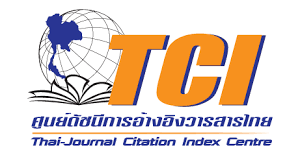Ethnobotany of Zingiberaceae for the Phu Thai Ethnic Group in Nakhon Phanom Province, Thailand
doi: 10.14456/mijet.2022.22
Keywords:
Zingiberaceae, Ethnobotany, Phu Thai ethnic group, Nakhon Phanom provinceAbstract
The objective of this research was studied indigenous knowledge of Zingiberaceae by the Phu Thai ethnic group in Nakhon Phanom province, Thailand. A field survey was performed through observation, participation and interview with local healers and general villagers. The data was analyzed by using Independent-samples t-test, One Way ANOVA, indices of informant consensus factor (ICF), fidelity level (FL%) and use value (UV). The results found that Phu Thai ethnic group continues to use Zingiberaceae for their life, and they got form home garden and forest around the village. A total of 21 species were utilized. They were used as edible about 16 species. Five species was cultural used. And two species was other plant used. Some species used more than one ethnobotanical uses but some use only one ethnobotanical uses. The many parts of plant were used; there were rhizome, leaf, shoot and inflorescence, respectively. The most part used was rhizome. Alpinia galanga is the highest use value or UV (0.41) and follow by lower use value. Kaempferia marginata is the lowest use value (0.04). The Informants’ consensus index factor (ICF) was found to range between 0.93 (Injuries) and 1.00 (each for Blood system disorders, Circulatory system disorder and Pregnancy/Birth/Puerperium disorders). The highest fidelity level (FL%) values were calculated for Zingiber officinale (80.83), showing the important species which most use for medicine in Phu Thai. While, the lowest fidelity level values were calculated for K. rotunda (10.67) which is less used for medicine Phu Thai. Older informants had highly significant knowledge on plant uses than the younger. Knowledge on plant uses was significant higher in the women. Ethnobotany of Zingiberaceae used by the Phu Thai ethnic group effects the interaction of their life style, beliefs, and rituals. Unfortunately, such knowledge is being lost, thus, these should be promoted and conserved.
References
A. Inta, P. Shengji, H. Balslev, P. Wangpakapattanawong, and C. Trisonthi, "A comparative study on medicinal plants used in Akha’s traditional medicine in China and Thailand," cultural coherence or ecological divergence. J Ethnopharmacol, vol.116, pp. 508–517, 2008.
A. Junsongduang, W. Kasemwan, S. Lumjoomjung, W. Sabprachai, W. Tanming, and H. Balslev, "Ethnomedicinal Knowledge of Traditional Healers in Roi Et, Thailand," Plants vol. 9, 1177, 2020.
B. Phokham, P. Wongsuwan, and C. Picheansoonthon, "Three new species of Kaempferia (Zingiberaceae) from Thailand and Laos," J Jpn Bot, vol. 88, no. 5, pp. 297–308, 2013.
GJ. Martin, Ethnobotany: "A Methods Manual," Chapman & Hall, London, 1995.
J. Leong-Škorničková, H.Đ. Trần, Q.B. Nguyễn, H. Kristýna, H.T. Lưu, Q.Đ. Nguyễn, T.T. Nguyễn, and M. Newman, "The identity of Amomum trilobum and Amomum unifolium (Zingiberaceae: Alpinioideae), and description of four new related species from Vietnam," Phytotaxa, vol. 401, no. 3, pp. 149–165, 2019. DOI: 10.12705/671.2.
KewScience 2021, World Checklist of Selected Plant Families (WCSP), 2021.
K. Srithi, H. Balslev, P. Wangpakapattanawong, P. Srisanga, and C. Trisonthi, "Medicinal plant knowledge and its erosion among the Mien (Yao) in northern Thailand," Journal of Ethnopharmacology vol. 123, pp. 335–342, 2009.
M. Phumthum, and H. Balslev, "Using ICPC-2 standard to identify Thai Zingiberaceae of pharmacological interest," Plants, vol.9, no. 7, 906, 2020. DOI:10.3390/plants9070906.
M. Phumthum, K. Srithi, A. Inta, A. Junsongduang, K. Tangjitman, W. Pongamornkul, C. Trisonthi, and H. Balslev, "Ethnomedicinal plant diversity in Thailand," Journal of Ethnopharmacol, vol. 214, pp. 90–98, 2018.
N. Saisor, P. Prathepha, and S. Saensouk, "Ethnobotanical study and utilization of plants in Khok Nhong Phok forest, Kosum Phisai District, Northeastern Thailand," Biodiversitas, vol. 22, no. 10, pp. 4336–4348, 2021.
P. Saensouk, and S. Saensouk, "Diversity, traditional uses and conservation status of Zingiberaceae in Udorn Thani Province, Thailand," Biodiversitas, vol. 22, no. 8, pp. 3083–3097, 2021.
P. Sirirugsa, "Thai Zingiberaceae: species diversity and their uses," International Conference on Biodiversity and Bioresources: Conservation and Utilization, 23–27 November 1997, Phuket, Thailand, 1998.
R. Pholhiamhan, S. Saensouk, P. Saensouk, "Ethnobotany of Phu Thai ethnic group in Nakhon Phanom Province, Thailand," Walailak Journal of Science and Technology, vol. 15, no. 10, pp. 679–699, 2018.
S. Saensouk, and T. Jenjittikul, "Kaempferia grandifolia sp. nov. (Zingiberaceae) a new species from Thailand," Nordic J Bot , vol. 21, no. 2, pp. 139–142, 2001. DOI: 10.1111/j.1756-1051.2001.tb01349.x.
S. Saensouk, and K. Larsen, "Boesenbergia baimaii, a new species of Zingiberaceae from Thailand," Nordic J Bot, vol. 21, no. 6, pp. 595–597, 2001. DOI: 10.1111/j.1756-1051.2001.tb00818.x.
S. Saensouk, and P. Saensouk, "Elettariopsis biphylla, a new species of Zingiberaceae from Thailand," Phytotaxa, vol. 159, no. 1, pp. 23–25, 2014. DOI: 10.11646/phytotaxa.159.1.4.
S. Saensouk, and P. Saensouk, "Kaempferia mahasarakhamensis sp. nov. (Zingiberaceae), a new species from Northeastern Thailand," Taiwania, vol. 64, no. 1, pp. 39–42, 2019. DOI: 10.6165/tai.2019.64.39.
S. Saensouk, and P. Saensouk, "Boesenbergia isanensis (Zingiberaceae), a new species from Thailand," J Jpn Bot, vol. 95, no. 2, pp. 65–68, 2020.
S. Saensouk, T. Boonma, and P. Saensouk, "Six new species and a new record of Curcuma L. (Zingiberaceae) from Thailand," Biodiversitas, vol. 22, no. 4, 1658–1685, 2021a. DOI: 10.13057/biodiv/d220410.
S. Saensouk, T. Boonma, and P. Saensouk, "A new species and a new record of Curcuma subgen. Curcuma (Zingiberaceae) from Northern Thailand," Biodiversitas, vol. 22, no. 9, pp. 3661–3670, 2021b. DOI:10.13057/biodiv/d220904.
S. Saensouk, T. Boonma, A. Thomudtha, P. Thomudtha, and P. Saensouk, "Curcuma wanenlueanga (Zingiberaceae), a new species of subgenus Curcuma from Thailand," Biodiversitas, vol. 22, no. 7, 2988–2994, 2021c. https://doi.org/10.13057/biodiv/d220752.
S. Saensouk, P. Saensouk, P. Pasorn, and P. Chantaranothai, "Diversity, Traditional Uses and New Record of Zingiberaceae in Nam Nao National Park, Petchabun Province, Thailand," Agriculture and Natural Resources, vol. 50, pp. 445–453, 2016. DOI: 0.1016/j.anres.2016.08.002.
S. Saensouk, P. Saensouk, P. Pasorn, and N. Chanshotikul, "Diversity and traditional uses of Zingiberaceae in Nakhon Phanom province, Thailand," Research & Knowledge, vol. 4, no. 1, pp. 47–55, 2018.
T. Chumroenphat, I. Somboonwatthanakul, S. Saensouk, and S. Siriamornpun, "Changes in curcuminoids and chemical components of turmeric (Curcuma longa L.) under freeze-drying and low-temperature drying methods," Food Chem, 339: 128121, 2021. DOI: 10.1016/j.foodchem.2020.128121.
T. Chumroenphat, I. Somboonwatthanakul, S. Saensouk, and S. Siriamornpun, The diversity of biologically active compounds in the rhizomes of recently discovered Zingiberaceae plants native to North-Eastern Thailand. Pharmacog Journal 11(5), pp. 1014–1022, 2019. DOI:10.5530/pj.2019.11.160.
Thailand, Nakhon Phanom, locator map, https://www.google.com/maps/place/ Accessed by 2021.

Downloads
Published
How to Cite
Issue
Section
License

This work is licensed under a Creative Commons Attribution-NonCommercial-NoDerivatives 4.0 International License.








